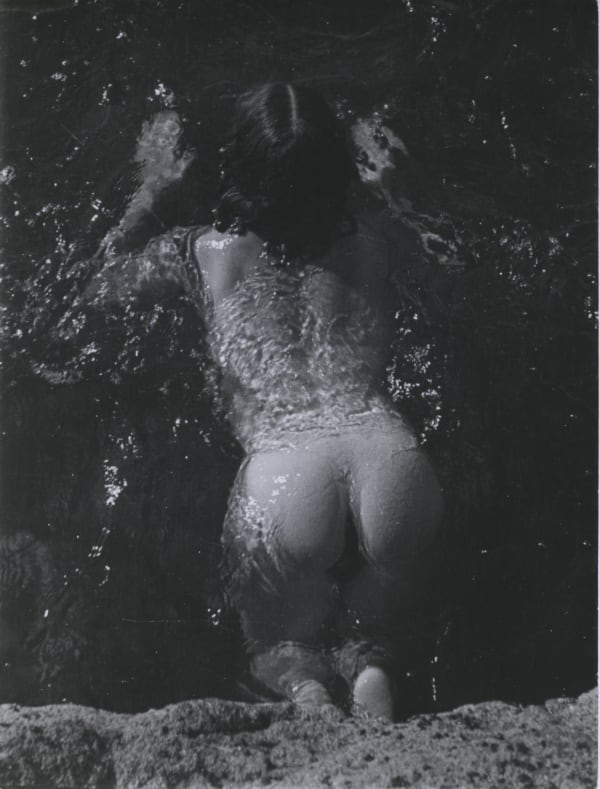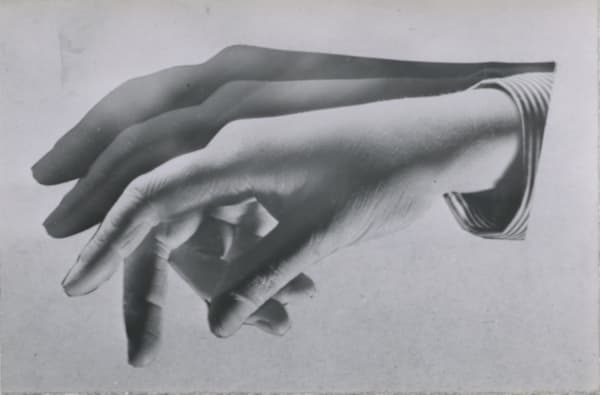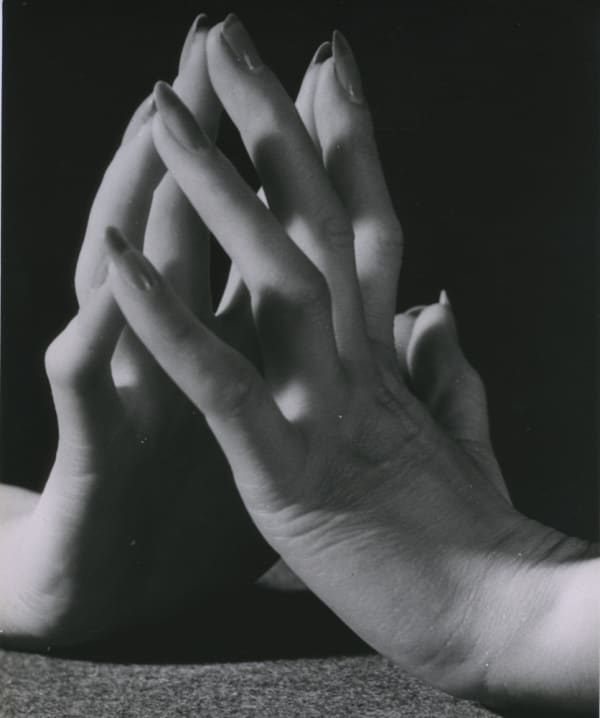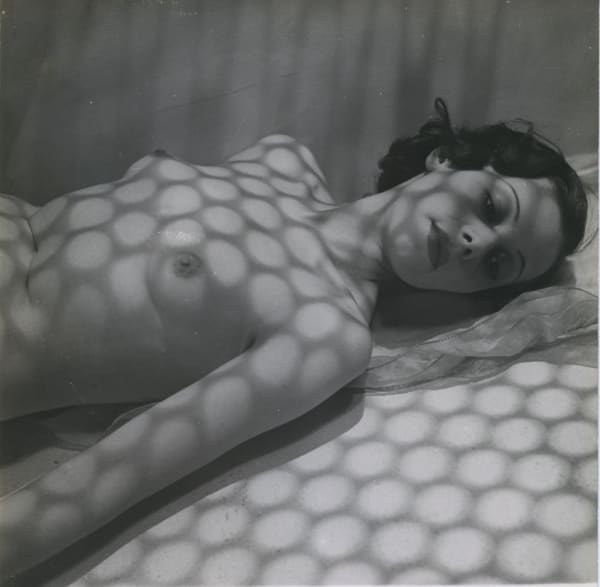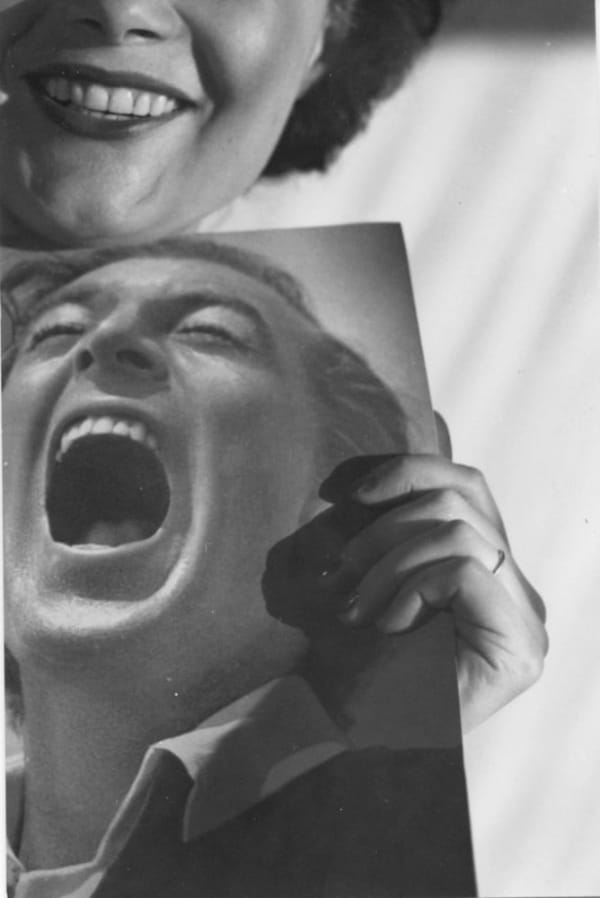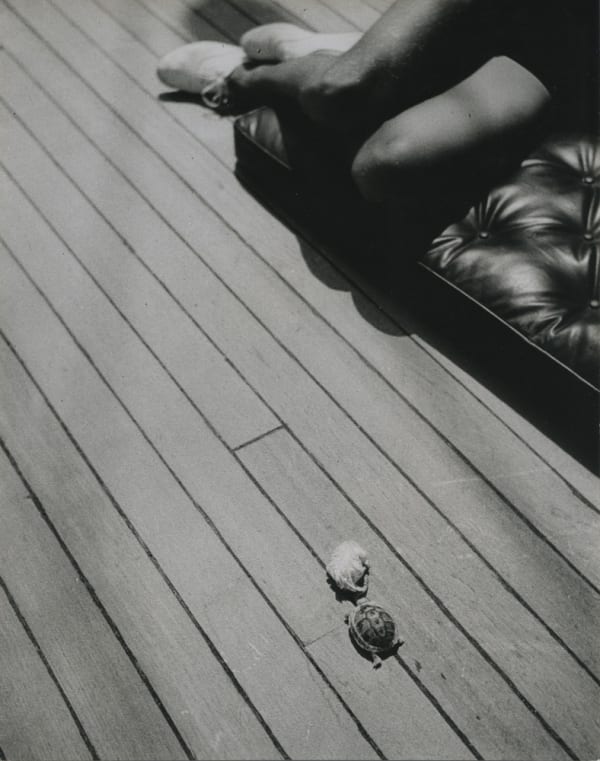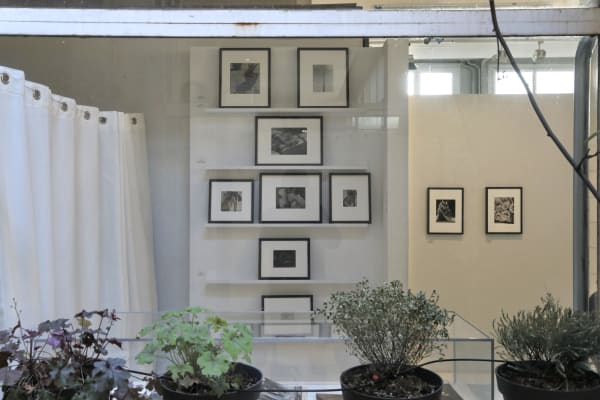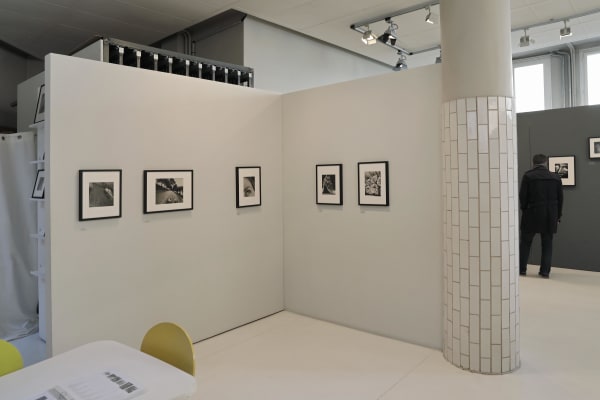La bascule du regard: Group show
It is with great pleasure that Les Douches la Galerie and Eric Rémy present La bascule du regard [The Turning Gaze], bringing together the works of Pierre Boucher, Jean Moral and André Steiner. Growing out of the Bauhaus, the artisans of the New Vision represent a generation of experimental photography in the 1920s, borne along by the technical promises of industrial society.
By disturbing points of view through games of scale, dizzying diagonal lines and compositions that border on the abstract, the New Vision multiplies the possibilities of photography and decisively turns its gaze toward the future.
-
 André Steiner, Oeil d'un hypnotiseur, c. 1930
André Steiner, Oeil d'un hypnotiseur, c. 1930 -
 André SteinerSans titreTirage gélatino-argentique d'époque21,8 x 16,2 cm
André SteinerSans titreTirage gélatino-argentique d'époque21,8 x 16,2 cm
Dim. papier: 21,8 x 16,2 cm -
 André Steiner, Sans titre, c. 1930
André Steiner, Sans titre, c. 1930 -
 André SteinerSouffleries de ChalaisTirage gélatino-argentique d'époque24,2 x 17,9 cm
André SteinerSouffleries de ChalaisTirage gélatino-argentique d'époque24,2 x 17,9 cm
Dim. papier: 24,2 x 17,9 cm
-
 André SteinerPortrait d'hommeTirage gélatino-argentique d'époque24 x 18,2 cm
André SteinerPortrait d'hommeTirage gélatino-argentique d'époque24 x 18,2 cm
Dim. papier: 24 x 18,2 cm -
 André SteinerSans titreTirage gélatino-argentique d'époque24,2 x 18 cm
André SteinerSans titreTirage gélatino-argentique d'époque24,2 x 18 cm
Dim. papier: 24,2 x 18 cm -
 André Steiner, Sans titre, 1937
André Steiner, Sans titre, 1937 -
 André SteinerRéflections dans un phare, MarocTirage gélatino-argentique d'époque24,1 x 18,2 cm
André SteinerRéflections dans un phare, MarocTirage gélatino-argentique d'époque24,1 x 18,2 cm
Dim. papier: 24,1 x 18,2 cm
-
 André Steiner, Sans titre, c. 1935
André Steiner, Sans titre, c. 1935 -
 André SteinerSans titreTirage gélatino-argentique d'époque23,4 x 17,8 cm
André SteinerSans titreTirage gélatino-argentique d'époque23,4 x 17,8 cm
Dim. papier: 23,4 x 17,8 cm -
 André SteinerSans titreTirage gélatino-argentique d'époque24,1 x 18 cm
André SteinerSans titreTirage gélatino-argentique d'époque24,1 x 18 cm
Dim. papier: 24,1 x 18 cm -
 André SteinerMasqueTirage gélatino-argentique d'époque24,2 x 18,1 cm
André SteinerMasqueTirage gélatino-argentique d'époque24,2 x 18,1 cm
Dim. papier: 24,2 x 18,1 cm
-
 André SteinerMasque solariséTirage gélatino-argentique d'époque21,4 x 18 cm
André SteinerMasque solariséTirage gélatino-argentique d'époque21,4 x 18 cm
Dim. papier: 21,4 x 18 cm -
 André SteinerMasque solariséTirage gélatino-argentique d'époque24 x 18 cm
André SteinerMasque solariséTirage gélatino-argentique d'époque24 x 18 cm
Dim. papier: 24 x 18 cm -
 André SteinerSans titreTirage gélatino-argentique d'époque23,8 x 18,1 cm
André SteinerSans titreTirage gélatino-argentique d'époque23,8 x 18,1 cm
Dim. papier: 23,8 x 18,1 cm -
 André SteinerSans titreTirage gélatino-argentique d'époque23,8 x 18,1 cm
André SteinerSans titreTirage gélatino-argentique d'époque23,8 x 18,1 cm
Dim. papier: 23,8 x 18,1 cm
-
 André Steiner, Sans titre, 1933
André Steiner, Sans titre, 1933 -
 André SteinerSans titreTirage gélatino-argentique d'époque23 x 17,8 cm
André SteinerSans titreTirage gélatino-argentique d'époque23 x 17,8 cm
Dim. papier: 23 x 17,8 cm -
 André SteinerSans titreTirage gélatino-argentique d'époque19 x 13,9 cm
André SteinerSans titreTirage gélatino-argentique d'époque19 x 13,9 cm
Dim. papier: 19 x 13,9 cm -
 André Steiner, Composition, 1930
André Steiner, Composition, 1930
-
 André SteinerÉtude de nuTirage gélatino-argentique d'époque13 x 13,2 cm
André SteinerÉtude de nuTirage gélatino-argentique d'époque13 x 13,2 cm
Dim. papier: 13 x 13,2 cm -
 André SteinerÉtude de mainsTirage gélatino-argentique d'époque6 x 9,1 cm
André SteinerÉtude de mainsTirage gélatino-argentique d'époque6 x 9,1 cm
Dim. papier: 6 x 9,1 cm -
 André Steiner, Étude de mains, c. 1934
André Steiner, Étude de mains, c. 1934 -
 André Steiner, Étude de mains, 1934
André Steiner, Étude de mains, 1934
-
 André Steiner, Étude expérimentale, c. 1935
André Steiner, Étude expérimentale, c. 1935 -
 André Steiner, Sans titre, c. 1928
André Steiner, Sans titre, c. 1928 -
 Pierre BoucherÉtudeTirage gélatino-argentique d'époque11 x 14,1 cm
Pierre BoucherÉtudeTirage gélatino-argentique d'époque11 x 14,1 cm
Dim. papier: 11 x 14,1 cm -
 Pierre BoucherSans titreTirage gélatino-argentique d'époque18 x 23,8 cm
Pierre BoucherSans titreTirage gélatino-argentique d'époque18 x 23,8 cm
Dim. papier: 18 x 23,8 cm
-
 Suzanne LarocheProduit de la merTirage gélatino-argentique d'époque18,8 x 18,2 cm
Suzanne LarocheProduit de la merTirage gélatino-argentique d'époque18,8 x 18,2 cm
Dim. papier: 23,8 x 18,2 cm -
 Pierre BoucherIsolateursTirage gélatino-argentique d'époque24 x 18,2 cm
Pierre BoucherIsolateursTirage gélatino-argentique d'époque24 x 18,2 cm
Dim. papier: 24 x 18,2 cm -
 Pierre Boucher, Nu rayé, c. 1935
Pierre Boucher, Nu rayé, c. 1935 -
 Pierre BoucherNu masculinTirage gélatino-argentique postérieur, resin coated23,4 x 17,1 cm
Pierre BoucherNu masculinTirage gélatino-argentique postérieur, resin coated23,4 x 17,1 cm
Dim. papier: 23,4 x 17,1 cm
-
 Pierre Boucher, Nu à la flamme noire (Étude pour les fleurs du mal), 1937
Pierre Boucher, Nu à la flamme noire (Étude pour les fleurs du mal), 1937 -
 Pierre BoucherSki nautiqueTirage gélatino-argentique d'époque17,8 x 22,5 cm
Pierre BoucherSki nautiqueTirage gélatino-argentique d'époque17,8 x 22,5 cm
Dim. papier: 17,8 x 22,5 cm -
 Pierre BoucherSans titreTirage gélatino-argentique d'époque21,3 x 20,3 cm
Pierre BoucherSans titreTirage gélatino-argentique d'époque21,3 x 20,3 cm
Dim. papier: 21,3 x 20,3 cm -
 Pierre BoucherNu avec ombresTirage gélatino-argentique d'époque17,9 x 17,9 cm
Pierre BoucherNu avec ombresTirage gélatino-argentique d'époque17,9 x 17,9 cm
Dim. papier: 22 x 17,9 cm
-
 Jean Moral, Le cri, 1938
Jean Moral, Le cri, 1938 -
 Jean Moral, La Seine, 1925
Jean Moral, La Seine, 1925 -
 Jean Moral, Mode, 1935
Jean Moral, Mode, 1935 -
 Jean Moral, Sans titre, c. 1932
Jean Moral, Sans titre, c. 1932
-
 Jean MoralJulietteTirage gélatino-argentique d'époque23,2 x 17,9 cm
Jean MoralJulietteTirage gélatino-argentique d'époque23,2 x 17,9 cm
Dim. papier: 23,2 x 17,9 cm -
 Jean MoralSans titreTirage gélatino-argentique d'époque26 x 18,9 cm
Jean MoralSans titreTirage gélatino-argentique d'époque26 x 18,9 cm
Dim. papier: 26 x 18,9 cm -
 Jean MoralLa colonne VendômeTirage gélatino-argentique d'époque29,2 x 23,2 cm
Jean MoralLa colonne VendômeTirage gélatino-argentique d'époque29,2 x 23,2 cm
Dim. papier: 29,2 x 23,2 cm -
 Jean Moral, Route, c. 1927
Jean Moral, Route, c. 1927
-
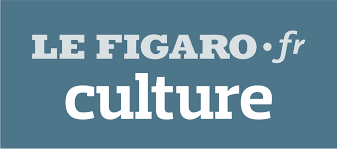
Visite virtuelle
Agathe Moreaux, Le Figaro Culture, 30 May 2019 -

La bascule du regard, Pierre Boucher, Jean Moral, André Steiner
Sophie Bernard, La Gazette Drouot, 24 May 2019 This link opens in a new tab. -
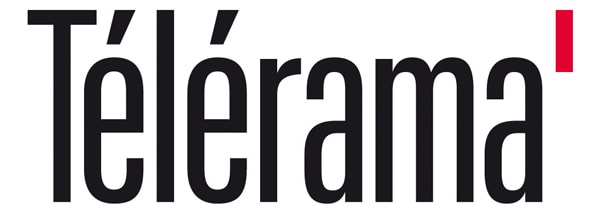
La bascule du regard
Frédérique Chapuis, Télérama Sortir, 8 May 2019 -
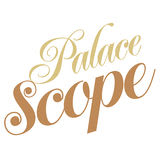
La bascule du regard
Palace Scope, 10 April 2019 This link opens in a new tab.
« The years 1927-1928 signal a modern turning point in France for French photography. In late 1927 in Paris, Germaine Krull published her book Métal which became one of the key works for the New Vision. As René Zuber (1902-1979) recalls with regard to the emblematic work, 'Twenty years ago, pointing her camera at the sky, Germaine Krull photographed the Eiffel Tower from the bottom up, and the Eiffel Tower fell on its face... From that day onwards, photographers went off to discover the world?"1
Looking at the world differently, gathering and bringing together the elements of a new visual grammar where the new (as well as the old) is perceived in a new light. That is the impetus of a new generation.
Modern photographers do not adopt the perspective of New Photography, they become the vectors of this new look at the world... They are all between twenty and thirty-five years old; in a certain sense, they find themselves decision-makers, and bereft (delivered also) of reference points, for their elders either disappeared in the first war or have abandoned their activity. Moreover, they have serious reasons for wanting to change the world. Thus for them any kind of innovation is fair game; it is the result of their desires and the mark of their access to the world of creation.
In the early 1920s, photography's good fortune was to open a breach in the larger public, while also becoming an indispensable means of information for the media that was being created in its modern form.
For them, the camera is no longer a tool for recording but for discovering. »
As Quentin Bajac states with regard to these young French and émigré (André Steiner) photographers, "Portraits, advertisements, press images, reproductions of works of art: when people make their start in photography, they often begin with applied photography »2.
The young photographers lent their vision to the technical innovations that were flooding daily life and that often called upon the new medium to promote them (automobiles, trains, boats, electricity, etc.).
Photography must convince and promote. It must carry within itself the technical revolution that floods daily life. Electrification, the development of the automobile...
It also tries to show its own aesthetic revolutions. It is at the confluence of graphic and technical investigations proper to the medium, and commissioned work (reportage, illustration, publicity, advertising, fashion, and so on) that the photographs of these three young photographers were created.
Electricity lines, roads, railroad tracks that criss-cross the landscapes, ocean liners, and so forth are so many new motifs and centers of interest. Those objects and technical structures carry within themselves a formal vocabulary that enriches new aesthetic investigations.
They are nothing more than games in deep blacks and greys, rhythms, repetitions and the conversion of simple forms into types of geometric and powerfully delineated still lifes. The subject is not only the object of photography, photography itself is at stake. Bodies, characters, elements of daily life are at the service of an image's composition.
The influence of the New Vision brought over from Germany was however less radical than in its country of origin. "... What is most arresting in the end is that this modernism as manifested in Paris is generally quite moderate... The French new vision was a tempered new vision of a peculiarly French classicism"3.
That may be due to the strong presence at the time of another current: Surrealism.Their photographic works were never part of only one trend; they were coloured by both influences according to the type of commission and investigation. Their photographic compositions then took on the disturbing strangeness that the Surrealists would try so hard to have surge from the banality of daily life.
Éric Rémy
Co-curator
















